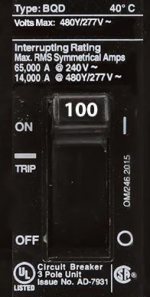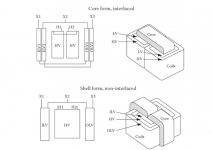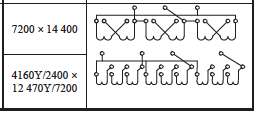- Location
- Wisconsin
- Occupation
- PE (Retired) - Power Systems
I have seen Schneider Electric transformers whose nameplate now says 'high and low' instead of 'primary and secondary'.You might want to acquaint the engineers with NEC 450.11(B)
I have seen Schneider Electric transformers whose nameplate now says 'high and low' instead of 'primary and secondary'.You might want to acquaint the engineers with NEC 450.11(B)
That's a good solutionI have seen Schneider Electric transformers whose nameplate now says 'high and low' instead of 'primary and secondary'.
That makes no sense to me, do you have a reference?Note there is a difference between a (V)/(2V) and a (V)x(2V) transformer, and all I could find are X on the 480 side. I dont really understand why, but the X is only for series or parallel operations and not for 3 wire service.
You mean a neutral? I don't run a neutral, but I do run a EGC.But as I just mentioned I think I would prefer a skipping the third conductor. Sure having it grounded in the center lowers the system to ground voltage, but does that really matter? What does that gain you?

See 250.32(B) Exception 2. For long outdoor feeders between outdoor transformers, you can save running an extra wire and use the grounded circuit conductor for fault clearing, omitting an EGC.You mean a neutral? I don't run a neutral, but I do run a EGC.
I think no matter what you have to run a EGC 250.32(B)
Ahh right, that could save some $$ with a long undergound pull.See 250.32(B) Exception 2. For long outdoor feeders between outdoor transformers, you can save running an extra wire and use the grounded circuit conductor for fault clearing, omitting an EGC.
Cheers, Wayne
I think he's saying the secondaries may be connected in series or parallel, but not series using X2-X3 as a center tap. The only difference I can see is the possibility of unequal loading.That makes no sense to me, do you have a reference?
I understand the statement, but I'm not buying it yet.I think he's saying the secondaries may be connected in series or parallel, but not series using X2-X3 as a center tap.
Which I don't see how it could be a problem.The only difference I can see is the possibility of unequal loading.
See the link in post #7That makes no sense to me, do you have a reference?
Cheers, Wayne
Thanks for the link. That document is "IEEE Standard for General Requirements for Liquid-Immersed Distribution, Power, and Regulating Transformers," but I guess dry transformers may be similar.As I said, I do not understand either why you can't use an "X" transformer for three-wire service, but that's what it says.
Okay, good catch on the liquid immersed, but yeah I can't imagine the it is different for dry types. It remains unclear to me the difference between the /and the x. Perhaps there is no difference and it is just an assumption on how it will be used, however note it does say "not for three wire service". Another question is whether you could use that just as a system grounding point, with no neutral loading, I assume so but I'm not certain.Thanks for the link. That document is "IEEE Standard for General Requirements for Liquid-Immersed Distribution, Power, and Regulating Transformers," but I guess dry transformers may be similar.
Do we have any examples of transformers that use the X nomenclature on the secondary side? I would think X would only show up on the primary side, as you wouldn't generally want to connect the supply side neutral.
So I guess my hypothesis is that if you have a 240x480 : 120/240 and reverse feed it, it would turn into a 120x240 : 240/480 transformer.
Cheers, Wayne
or interlaced vs non-interlaced?I think he's saying the secondaries may be connected in series or parallel, but not series using X2-X3 as a center tap. The only difference I can see is the possibility of unequal loading.

Is interlaced like bifilar winding?or interlaced vs non-interlaced?
See the link in post #7
240 x 480-120/240 V Transformer Ratio
Greetings, Gents - I'm a little confused on '240x480' designation on the high side of the transformer. This is different from ' 480-120/240' designation. Does this mean that I can connect either 240V or 480V supply on the primary and get 240V/120V on the secondary side? What does "X' mean in...forums.mikeholt.com
As I said, I do not understand either why you can't use an "X" transformer for three-wire service, but that's what it says.

So what would be different inside the transformer enclosure between a terminal intended for connecting premises wiring and a terminal intended only for a configuration jumper?Perhaps the "X" is placed between the voltages from different and distinct winding arrangements that are configured via jumpers, but all of the voltages within each arrangement may not be available on the output terminals that are provided.
So what would be different inside the transformer enclosure between a terminal intended for connecting premises wiring and a terminal intended only for a configuration jumper?
Cheers, Wayne
